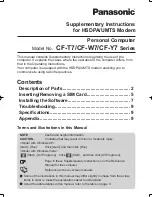
Part III: Appendixes
Glossary
297
controller:
An electronic device that automatically operates a unit or
regulates a process. For example, the computer’s built-in disk drive
controller takes information from the computer and translates it into
a form usable by the hard drive. Unlike an adapter, which in its
simplest form can be hardware only, a controller always includes
firmware or software. A controller can take a number of forms, such
as a chip on the motherboard or a PC Card. See also
adapter,
firmware, hardware, software.
conventional memory:
The first 640 KB of random access memory
(RAM) where the operating system runs programs and stores
information. Also called base memory.
cooling method:
The method used to keep the computer’s internal
temperature at an operating level that is safe for the computer. There
are two methods available: using a cooling fan or reducing
processing speed. The fan is the better choice when you are running
the computer from an electrical outlet, but reducing processing
speed saves power when you are using the battery.
cursor:
A symbol that indicates the current position on the screen. The
shape of the cursor varies, depending on the program you’re using
and what you’re doing.
D
data:
Information that a computer can process. The word “data” is
actually plural for “datum,” meaning a single piece of information.
data bits:
A data communications parameter controlling the number of
bits used to represent a character. If data bits = 7, the computer can
generate 128 unique characters, if data bits = 8, the computer can
generate 256 unique characters.
decimal:
The base-ten numbering system normally used by people.
Computers, in contrast, generally use binary or hexadecimal
numbering systems. See also
binary
,
hexadecimal
.
default:
The values or options selected by the processor, a controller or
program when you do not specify a setting. For example, a preset
value in a dialog box or window.
delete:
To remove information. Examples are removing a line of text
from within a program or removing files from a disk or other storage
device. Synonymous with erase.
Summary of Contents for 8100 series
Page 17: ...xvii ...
Page 24: ......
Page 55: ...Part I Getting to Know Your Computer Getting Started When and how to turn off the computer 29 ...
Page 111: ...Part I Getting to Know Your Computer Learning the Basics Caring for your computer 85 ...
Page 136: ......
Page 185: ...Part II Technical Reference Toshiba Utilities Expansion device properties 159 ...
Page 219: ...Part II Technical Reference Keeping Your Files Safe Hard disk drive passwords Windows NT 193 ...
Page 277: ...Part II Technical Reference Troubleshooting Guide Toshiba s worldwide offices 251 ...
Page 278: ......
Page 285: ...Part III Appendixes Hot Keys 259 ...
Page 286: ...Appendix B Built in features 261 Optional accessories and devices 268 Specifications 270 ...
Page 298: ...Appendix C ...
Page 308: ...Appendix E ...
Page 312: ......
Page 342: ...Part III Appendixes Glossary 316 ...
















































